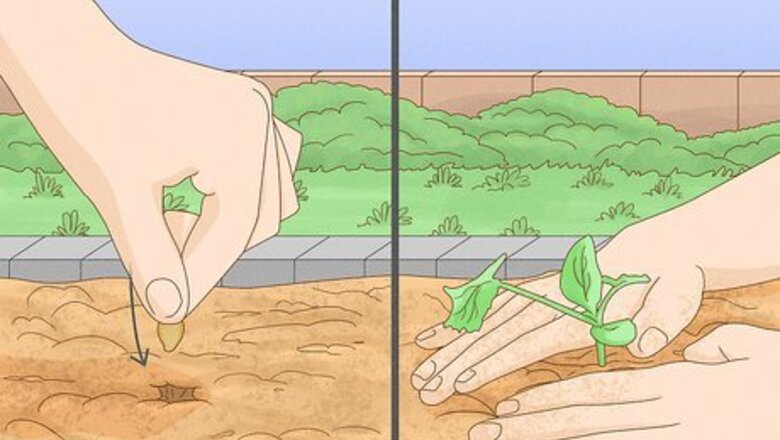
views
Preparing to Plant
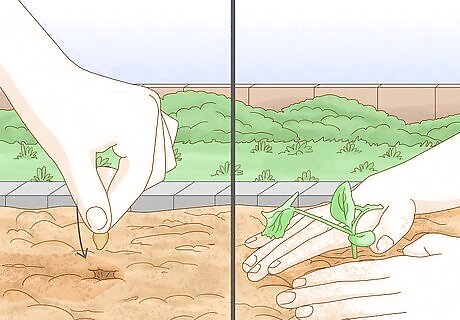
Decide how you’re going to start your zucchini. There are two general methods of propagating zucchini - either by planting seeds, or by purchasing a small pre-existing zucchini plant and transplanting it to your garden. If you choose to grow your zucchini from seeds, you’ll have to start your seeds 4-6 weeks prior to the planting time outdoors for your environment/location. Grabbing a pre-potted plant is always easier and less time-consuming, but may not be as fulfilling as starting your zucchini from seeds. There are a few kinds of zucchini, but the squash are all generally the same. You might see zucchini as classified as ‘open habit’ or ‘dense habit’, which refers to the way the leaves grow on the bush (sprawling/vine-y or bush-like). Most bush varieties of zucchini are considered summer squash, while vine varieties are considered winter squash. Zucchini will vary naturally between a yellow-ish hue and a green so dark it is nearly black. Some have very mild stripes/spots, this is normal and should not be concerning.
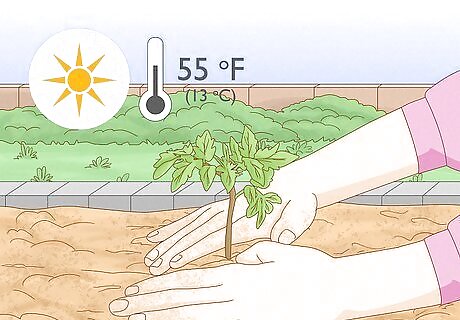
Know when to plant. Zucchini is typically considered a summer squash, because it thrives and produces the best fruit in summer. Some varieties are considered winter squashes, but this has to do with the time of fruiting, rather than the time of planting. Zucchini are sun loving and won’t do well in cold soil. Therefore, plant your zucchini when the temperature of the soil outdoors is at least 55 °F (13 °C). This is normally after the first or second week of spring, after all chance of frost have passed. If you’re not sure when to plant, call your local agricultural extension for detailed information on planting times for zucchini in your area.
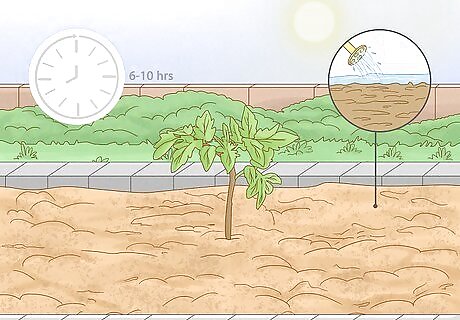
Find the perfect planting location. Zucchini will thrive in an area that gets full sunlight with plenty of room to spread out. Find a location in your garden that will supply the zucchini with at least 6-10 hours of sunlight per day, and that lacks too much shade. Be sure to select a plot that has well draining soil; zucchini like moist soil, but not soggy soil. If necessary, improve drainage by planting the zucchini on soil mounds, or through larger changes such as soil amendment and drainage systems. Plant in an area with southern exposure for maximum sun (or northern exposure in the Southern Hemisphere).

Prepare your soil. Although not everyone has the time to, preparing soil several months in advance will allow for the best growing conditions for your zucchini. Start by mixing in a gardening mulch and fertilizer, to supply the soil with the necessary nutrients. Test the soil pH, and amend it if necessary; zucchini prefer a soil environment with a pH between 6 and 7.5. To make the soil more acidic (lower pH), mix in peat moss or pine needles. To make the soil more alkaline (higher pH), mix in lime. To add nutrients and organic material, till compost into the soil a month before planting, then cover with mulch until time to plant. If your soil does not drain well, mix in some sand to help encourage water drainage.
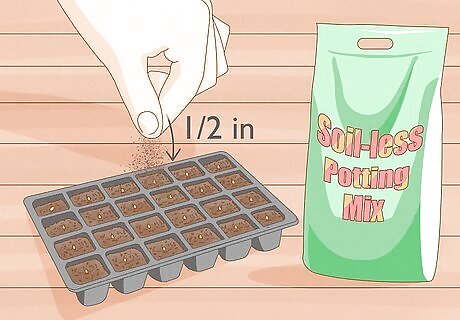
Start your seeds. If you’d rather not take chances of sowing your seeds directly into the soil, you can start your zucchini seeds indoors 4-6 weeks prior to transplanting them outdoors. Grab seed trays, soil-less potting mixture, and your seeds. Place a single seed in each tray, cover with ⅛ inch of potting mixture, and water well! These should be placed in an area that gets sunlight and is at least 60 °F (16 °C). When the second set of leaves have sprouted, the zucchini starts are ready to be transplanted outdoors.
Planting Your Zucchini

Prepare your plot. Use a gardening trowel to dig a small hole for your zucchini plant. If you’re planting seeds, you’ll need to stick each seed less than ½-inch under the soil. For zucchini starts, dig each hole to be slightly larger than the root ball on your plant. Keep 75–100 centimeter (39.4 in) space between each plant (same distance for row space). You can thin out seedlings if needed.
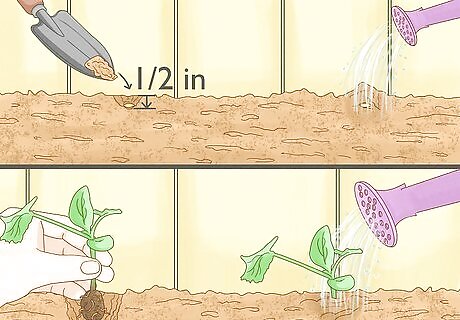
Plant your zucchini. Place each zucchini seed or start into its own individual hole. Cover seeds with ¼ or ½ inch of soil, so that they are able to get the necessary sunlight and water for germinating. Cover up a zucchini transplant with enough soil to cover the root ball without reaching up the stem. Finish up planting with a heavy watering, and you’re done!
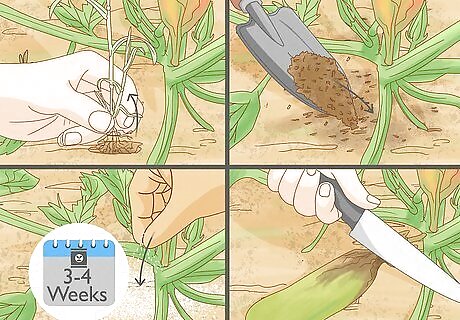
Maintain your zucchini plants. Keep an eye on your zucchini as they begin to grow. They’re relatively low-maintenance plants, but they do require a bit of upkeep in order to stay in tip-top producing condition. Pull out any weeds on site, and apply a layer of mulch if weeds continue to be a problem. Add a liquid growth fertilizer every 3-4 weeks to help promote growth in your zucchini. Cut off any diseased or dying fruit or branches to prevent disease from spreading to other parts of the plant, and to promote continuous growth.
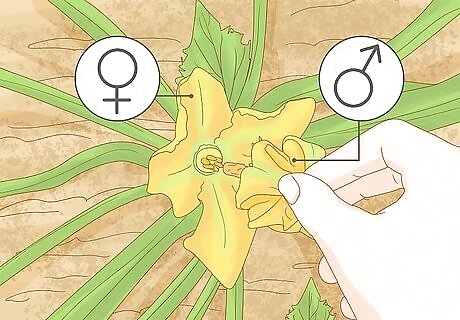
Promote growth. In order for your plant to start producing zucchini fruit, it has to become pollinated. If you lack bees or other pollinating insects in your area, or if your zucchini plant doesn’t seem to be producing any squash, you can pollinate your plant on your own. Pick a male zucchini flower, identifiable by its long stem, slender stem, and a visible stamen in the center. Carefully pull back the blossoms on the stem, and rub the stamen inside a female zucchini flower. Female zucchini flowers have short stems, a bulbous growth where the flower meets the stem, and lack stamens. You can do this to several flowers or just a few, depending on the amount of time you have and the growth you’re trying to promote.
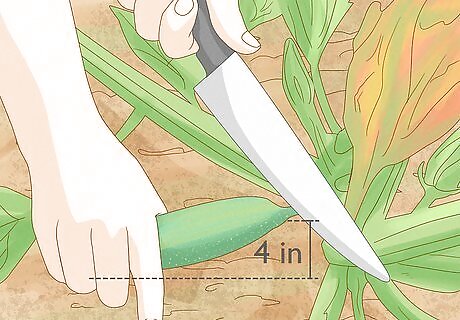
Harvest your zucchini. When zucchini have grown to at least 4-inches in length, they are ready to be picked and eaten. Picking zucchini regularly promotes more squash production. Therefore, if you want lots of the squash, then pick all the zucchinis as they reach maturity. If you don’t have a need for too many squash, leave one or two zucchinis on the vine for the whole growing season to slow down the production. To harvest your zucchini, use a sharp knife to sever the squash from the rough stem that attaches it to the bush. Enjoy the flowers in salads. These are edible and if you pick them, there won't be so many zucchini fruits growing. Crops will continue to grow until the first frosts if they established well during spring. You can simply cut the stem of a zucchini to promote growth, if you don’t want to harvest all of your squash yet.














Comments
0 comment